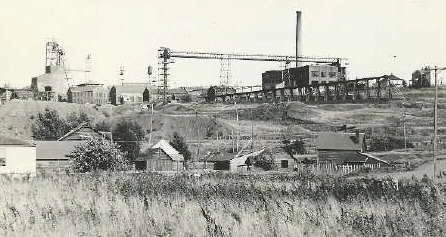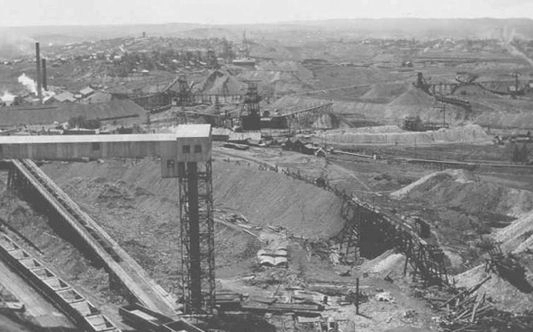- Details
- Hits: 3306
Mine: Newport Mine, Ironwood, MI
Iron King Mine → Newport Mine → Became
Operated for: 64 years.
From: 1886
Owned by: Youngstown Mines, Newport Mining Co.
Produced: Iron Ore. Soft, red, non-Bessemer. Underground mine.
Method: Underground - multiple shafts. Numbered shaft on north vein. Lettered on the south vein.
Railroad connection: C&NW and Soo Line to Port of Ashland
Until: 1950
Lifetime Production: 32,040,616 tons.


Notes
The Newport Mine in Ironwood was formally known as the Iron King Mine. It opened in 1886, one of the first mines in the range. It was located east of the Pabst Mine and west of the Bonnie Mine, covering the northwest 1/4 of Section 23 of T47N-R47W.
It was owned by the Youngstown Mines Company and the Newport Mining Company.
It occupies a high rise of ground immediately to the east of the Pabst Mine.
Photo Info: Top, the Newport Mine, south of Ironwood. Another aerial view at a different time. 2nd photo, [MINART]
Time Line
1899. The Newport Mine occupies a high rise of ground immediately to the east of the Pabst mine. It is operated by Ferdinand Schlesinger and still retains its old title of "The Newport Iron company". For 1898 it sent to market 196,953 tons, exceeding the product of 1897 by 35,975 tons. It has a record of 1,453,263 tons.
Of late years, the Newport has not been an easy mine to handle. Its ore bodies have been much split up, have been irregular and it has taken a great deal of dead work to get the property in shape for production. This is a great contrast to the conditions which prevailed when mining was being carried on nearer the surface. Then the ore bodies were large and regular and almost entirely free from rock intrusions, and the cost was easier to keep down than at present when so much is needed for the opening and development of new property.
As true of its neighbor the Pabst (mine), the Newport has two veins, the "north" and "south". On the north vein the shafts are numbered and upon the south run of ore shafts are lettered. Up to within a few months ago, nothing had been done upon the north vein for several years. They are now taking shaft pillars between shafts Nos. 1 and 2. There is considerable ore yet here to be mined between the shafts and up on top of the dyke. Some work is also being done at different points between No. 2 and 1 shafts, scramming out the ore here and there wherever it can be found. There has been considerable ore revealed in some of the old levels where it was supposed the deposits had been exhausted, but the present year will see it pretty well cleaned out.
At "K" shaft, which is at the east end of the south vein as thus far exploited, they are continuing the development of the ore body which they have been working upon for several years past. Since our last report they have added a 10th level, which has a thickness of 110 feet, and are well along for the 11th lever which will be 50 feet below the 10th, and 755 feet below surface.
From the 10th level they put in a drift 303 feet to the west before the ore was encountered. They are now 16 feet in ore of fine quality. They are mining about 150 tons per day which comes from the west end of the property. The ore at this point is considerably further away from the shaft located in the footwall. At the 9th level ore was struck at a distance of 217 feet from the shaft, while 110 feet deeper it was 303 feet away. There is a small dyke met with which has caused a throwing of the ore to the west.
At the 9th level of K shaft they had figured to take the ore on the caving plan but were unsuccessful, it being too hard to come down as they should have had it in order to secure a successful working of the plan. Failing in this, they cut out the level in two, calling the upper portion the 8th level and the lower the 9th. The ore in some places is very stubborn, and will not settle from the handing so that it can be mined to the best advantage.
They have a decided faulting of the dyke in this shaft, and this has permitted the finding of ore beneath the main dyke. There has been much speculation indulged in as to whether or not there would be merchantable deposits of ore revealed under the dykes in this range. It has been clearly proved at several mines that the ore does make beneath them, and that it exists at a depth of at least 1,500 feet at one point.
The management has hopes of finding the main dyke of the Norrie mine at a depth of 400 feet below the present bottom level of K shaft. Calculations have been made upon the pitch of the Norrie dyke which comes in from the west, and it is thought that it should be found at about 1,150 feet from the surface.
At "A" shaft there is also a plain faulting of the dyke, and there has been considerable disturbance of the formations at this point. At this shaft, as well as the others on the south deposit, they are taking pillars. Nothing new is being opened up. At "F" shaft located a short distance from the mine office, and which was an exploring shaft started some years since and worked in but a short time, they are now doing some work with a view to testing the formation at this point. They have pumped out the water and have done about 400 feet of drifting, finding nothing of value.
It is at greater depths that the company hopes for ore to given them an excuse for continued products. They have opened upon the trend of the mine a distance of 2,200 feet, and while they have territory still practically unexplored, they have an idea that they ought to have a continuation of the big deposits of the Oliver Mining company, which are located to the west of their line, and which have been very persistent in their strike.
The company is mining about 19,000 tons of ore per month and has neat stockpiles from which to begin shipments this year. A force of 350 men is employed. J. R. Thompson is superintendent; Thomas Oliver, mining captain, V.B. Sherrod, engineer and chemist; M. E. Russell, cashier. [INR-1899-0527]
1910. William Hakala is dead as the result of an accident at the Newport Mine. Hakala fell 800 feet. He was assisting in straightening out a "kink" in the hoisting cable. His body was horribly mangled. He was aged 29 and married. [BBAN-1910-0324]
1929. July 29. A tornado strikes the Newport Mine, collapsing buildings and removing roofs at about 1:00 am.
1938. Mining activity on the range took on a brighter look today with a report that the Anvil and Newport mines would open tomorrow and with the yard depot report this morning that ore shipments were good last week. The two properties will operate on a three days a week basis with two shifts being employed. These mines have been idle, except for maintenance crews, since July. The resumption of operations will affect approximately 300 men. [IDG-1938-1031]

